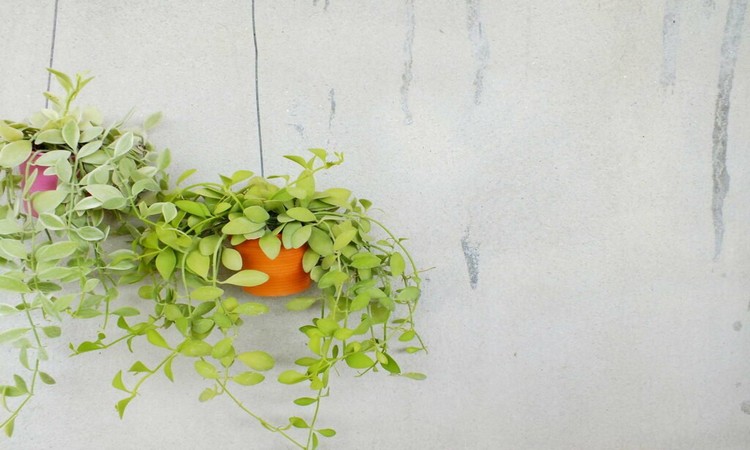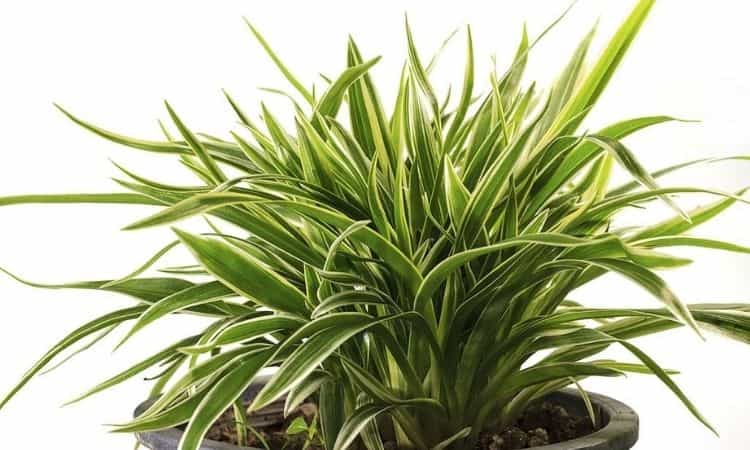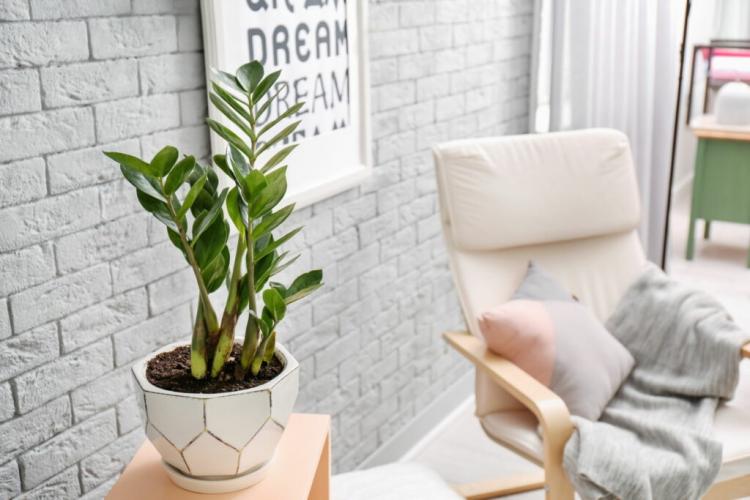Cyrtomium
The Cyrtomium plant is a member of the Aspidiaceae family. This genus unites more than 10 species, and most often in room culture, you can meet Cyrtomium falcatum. This plant is native to southern Africa, the islands of Hawaii, Korea, South America, India, Japan, and the Himalayas. At the same time, Cyrtomium prefers to grow in subtropical and tropical latitudes. Despite the fact that this fern is quite resistant to cold, it can be cultivated outdoors only in regions with a warm climate. At the same time, in temperate latitudes, it is recommended to grow it exclusively in indoor conditions, since in the open ground in winter it will freeze out even in the presence of shelter.
Such a plant is often called phanerophlebia. However, among the people, it still has several names, namely: “holly”, “sacred fern”, and “holly”.
In height, this perennial herb can reach from 0.4 to 0.6 meters. It has an ascending or erect rhizome, which is rather short. Its surface, together with the basal parts, has a dense coating consisting of scales. These scales are usually two-colored, but can also range in color from brownish black to dark brown. There is sharpening at the top of the scales, and their shape can be broad-lanceolate or ovoid, and their edge is fringed, solid, ciliated, or serrated.
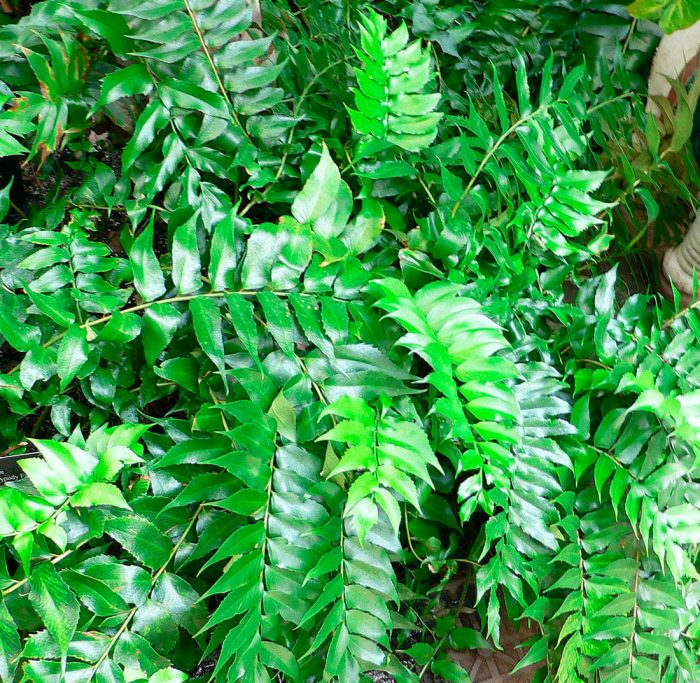
Fern leaves are called vayas, they form a wide rosette. Cirrus leaf plates have opposite lobes. Alternately located fronds have a saber shape, their length can vary from 0.35 to 0.5 meters. The leaves are bright green and leathery to the touch. The lobes of the leaf plates are pointed at the apex and can have a very different shape: lanceolate, broadly lanceolate, linear-lanceolate, oval-lanceolate, or deltoid-ovate. Their edge, as a rule, is wavy, and 1 or several leaves at the apex at the base have 2 teeth.
Veins are clearly visible on the surface of the leaf blades, which form a mesh pattern. Their front surface is glossy, there are short petioles, which are often covered with hairs. In specialized stores, the most common variety is “Rochfordianum”, the edges of its leaf blades are serrated.
On the surface of the leaf plates, there are rounded sporangia – these are special organs whose task is to form spores. The same organs are found in fungi and algae. Sporangia of Cyrtomium are orange or brown in color. Sporangia are located on the seamy surface of the leaf plates, and they cover the leaf evenly.
This fern is quite suitable for growing both experienced and novice growers. The fact is that it is distinguished by its unpretentious care. The only thing to consider is that Cyrtomium is a slow-growing plant. The fern grows especially slowly at a young age, and even in an adult bush, only a few leaf plates grow during the year.
Home care for Cyrtomium
Table of Contents
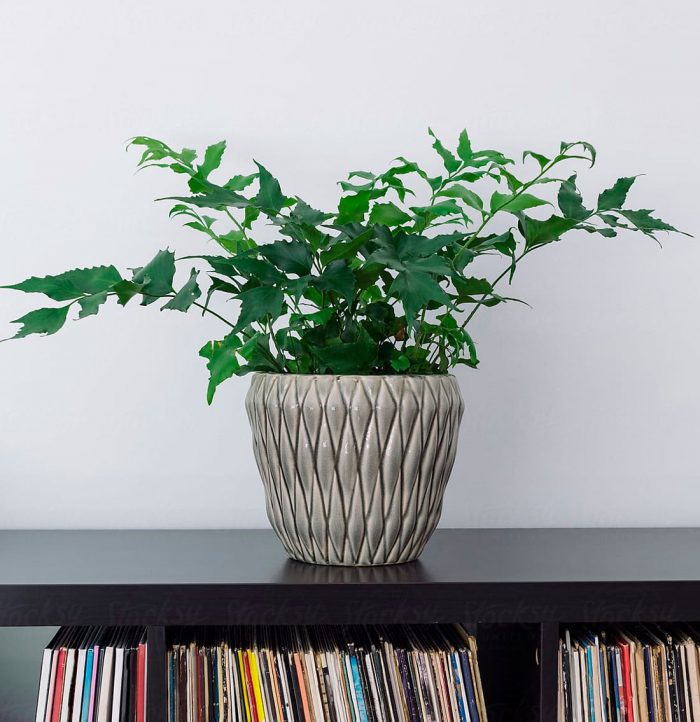
Lighting
Under natural conditions, Cyrtomium prefers to grow under trees in the lacy shade of their branches. That is why it is recommended to choose a place with diffused sunlight for such a plant at home. Also, the bush can be placed in a shaded place. A north-facing window sill is best suited for it. If you put the fern on some other window, then it will need to be shaded from the direct rays of the sun. If there is room for the flower only near the south window, then place it as far back as possible in the room, trying to keep it in shade.
Temperature regime
In the spring and summer months, the plant feels most comfortable in the warmth – from 23 to 25 degrees. However, if the room is very hot, then it will be necessary to increase the level of humidity. Experts advise, in winter, to put the bush in a cool room (from 15 to 18 degrees). During airing, be extremely careful at any time of the year, because Cyrtomium reacts extremely negatively to a draft.
Air humidity
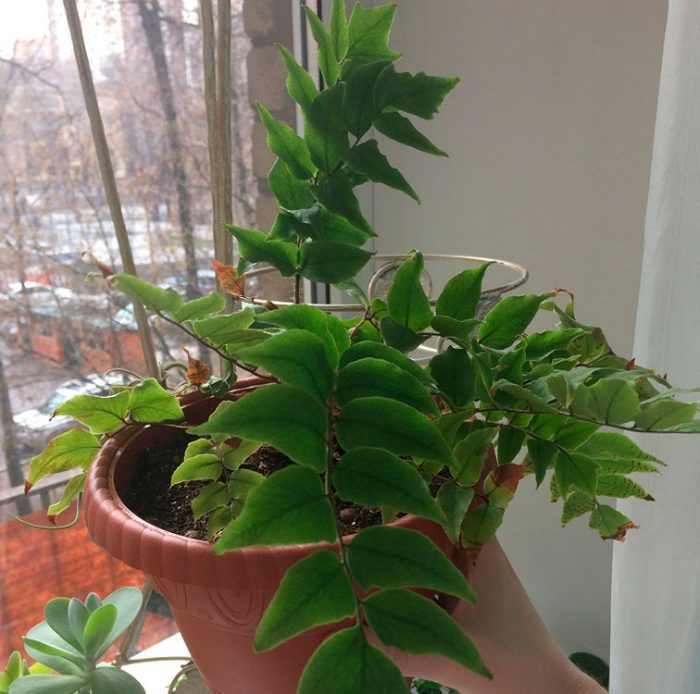
Such a plant does not need high humidity. It feels quite comfortable in a room with dry air. But on hot days in summer, when it is very hot in the room, the bush needs to increase the humidity of the air. To do this, it can be systematically humidified from a spray bottle or use a household air humidifier.
Watering
Despite the fact that nature Cyrtomium prefers to grow in shaded places with high humidity, it is not worth overly moisturizing the soil mixture in the pot, because this can lead to decay of the root system. But at the same time, watering should be abundant and regular.
In spring and summer, on average, you need to moisten the soil mixture in a pot once every 2 or 3 days. With a cool winter, the plant does not need a lot of moisture, while it is watered about 1 time in 7 days. Water for irrigation must be soft, while its temperature is slightly higher than room temperature.
Topdressing
During the growing season, feeding of Cyrtomium is carried out 1 time in 3 or 4 months. For this, mineral complex fertilizers are used, which are introduced into the soil mixture in the form of a solution. Its concentration should be 2 times weaker than that indicated on the packaging by the manufacturer. You can also use organic fertilizers to feed the bush, for example, mullein solution.
Cyrtomium transplant

The fern is transplanted, as a rule, in the spring, but this is done only if necessary, for example, if it has grown a lot. The fact is that its root system is rather fragile. Make a drainage layer at the bottom of the flowerpot, the thickness of which should be equal to 20-30 mm. To do this, you can use pieces of brick, medium-sized pebbles, or expanded clay, as well as shards from ceramic or clay products. Cyrtomium is transplanted by the transshipment method: in this case, the bush is pulled out of the old container very carefully and planted in a new pot, while trying not to destroy the earthen lump.
Further, all voids are filled with fresh earth mixture. After transplanting, check the root collar, it should not be buried, it should definitely be left at the same level. During transplantation, you can use purchased ready-made soil mixtures made specifically for ferns. They should be loose and well-drained. If desired, the substrate can be made by hand; for this, combine the leafy soil, peat, and sand in a 1: 2: 1 ratio. To improve the drainage qualities of the substrate, it is recommended to add a small number of small pieces of pine bark and charcoal, as well as chopped sphagnum to it.
Reproduction methods
Growing in room culture, Cyrtomium can be propagated by dividing the bush, or it can be grown from freshly harvested spores.
Rhizome division
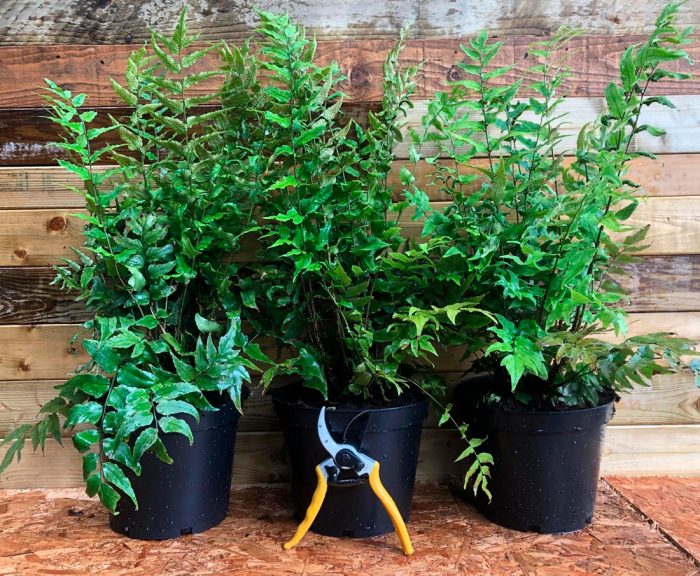
Fern propagation by dividing the rhizome is carried out in spring, combining this procedure with a bush transplant. An adult and overgrown bush is suitable for this. First, remove the flower from the container and remove the excess soil mixture from its rhizome. Take a very sharp knife and carefully divide the rhizome into several pieces. In this case, the cut-off parts of the bush should be quite large: there should be several leaf plates, root processes, and at least three growth points on the division.
Further, all places of cuts must be processed with charcoal crushed to a powdery state. If necessary, you can use ordinary activated carbon in tablets instead, which is also carefully crushed. Plant the dividers in individual containers, and at the bottom, be sure to make a drainage layer. At first, do not expose the dividers in places with a lot of sunlight, but keep them in the shade.
Growing up from spores
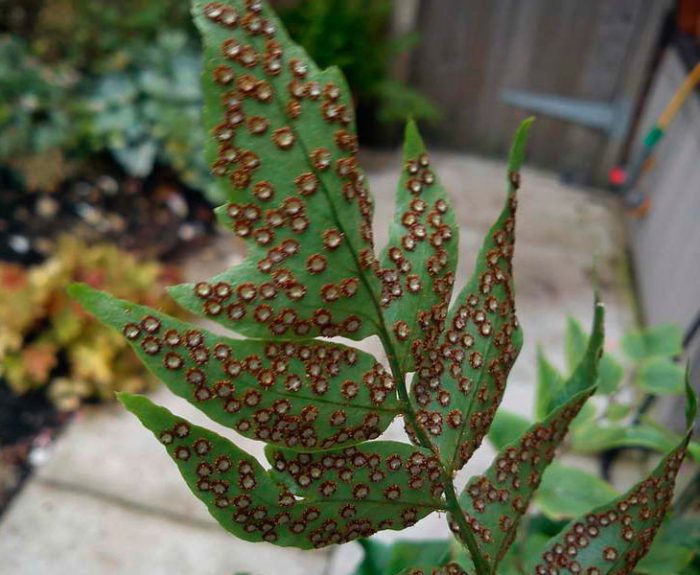
It is rather difficult to propagate Cyrtomium by spores. To begin with, gently scrape the ripe spores onto a piece of paper from the seamy surface of the leaf wai. Carefully make an envelope out of it and leave it in the open air to dry the spores. In order for them to germinate successfully, you will need to build a mini-greenhouse with bottom heating. Take a tall and wide container with a lid (preferably made of plastic) and place a regular brick on its bottom. Then it is covered with a layer of pure peat on top. Pour distilled water into the container so that its height is approximately 50 mm.
When the seed container is ready, take the spores and spread them evenly over the peat surface. Cover the crops with a lid on top (you can use transparent glass or film instead). To succeed, it is necessary to prevent the water level from dropping, and also to maintain the air temperature in the range of 20 to 22 degrees. Place the container in a shaded area.
After a few months, the surface of the substrate will be covered with green moss. When this happens, the water level should be raised slightly. For some time, the sprouts that appear should be under a thin layer of water. If everything is done correctly, then after a while small leaves will form on the seedlings. After the sprouts reach 50 mm in height, they should be transplanted into individual containers.
Possible problems
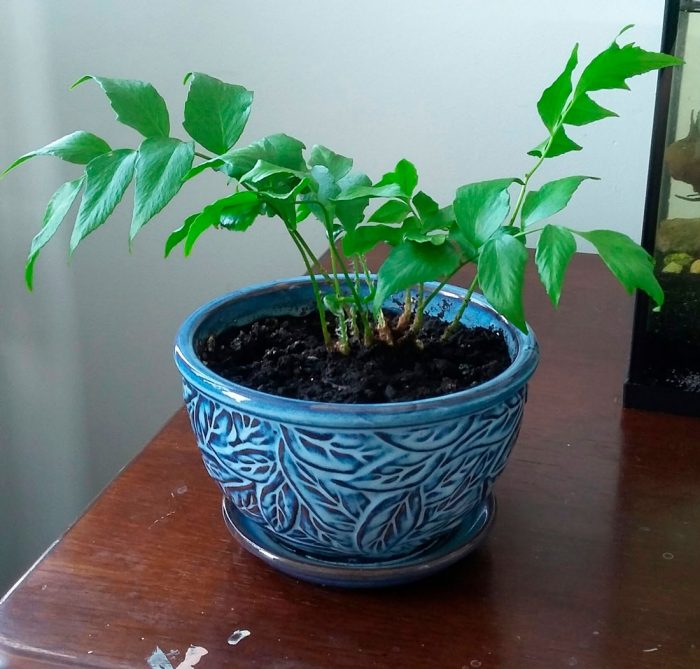
If optimal conditions for growth have not been created for home Cyrtomium, then there is a high probability that mealybugs, spider mites or scale insects can settle on it. To get rid of these pests, several treatments with a suitable insecticide are required.
Also, a grower with such a fern may have the following problems:
- Slow growth and faded leaf plates. The bush suffers from excess sunlight. Move it to a shaded area.
- Brownish spots appear on the upper fronds, and the lower ones turn yellow. This is due to excessive watering and stagnation of water in the substrate. In this case, moss may also appear on the surface of the soil mixture.
- Drying and folding of foliage. This is due to the drying out of the earthen coma in the pot. Remove all leaf fringes from the fern and water well. After some time, young green foliage will grow on the bush.
- The bush begins to grow more slowly, leaves wilting, and salt deposits appear on the surface of the soil mixture. The fern is watered with excessively hard water.
- The slowdown in growth. This may also be due to the fact that the bush needs feeding.
Cyrtomium and superstition
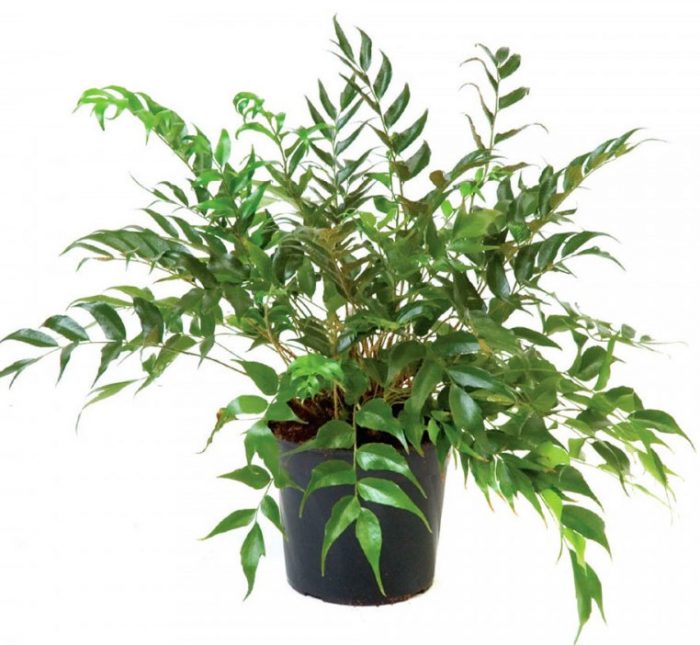
As with many other ferns, a large number of superstitions and signs are associated with themCyrtomium. For example, it is believed that such a fern will make its owner more hardy and strong.
But most superstitious flower growers believe that absolutely all ferns are energy vampires, and therefore they should in no case be kept in their apartment. It is believed that a plant requires a large amount of energy for normal health. That is why it takes it away from everyone who has it, and people are no exception. However, experienced growers are confident that this property is easy to neutralize: just move the bush to a place that is considered energetically unfavorable, for example, place it near a TV or computer.
Scientists have long studied such a plant and can say for sure why residents may feel bad when growing Cyrtomium in indoor conditions. Firstly, allergy sufferers may experience an allergic reaction to spores that form on the seamy surface of the leaves. Secondly, if the bush is in the bedroom, then a person can feel severe headaches in the morning. The fact is that in the dark, the plant absorbs a large amount of oxygen from the air and contributes to the release of carbon dioxide.
If a person was born under the constellation Gemini, then for him Cyrtomium can become a real “living” amulet. The fact is that such a fern improves the communication skills of its owner, and also helps him to quickly find a common language with other people.
Types of Cyrtomium with photos and names
Cyrtomium falcatum

Or Fanerophlebia sickle (Phanerophlebia falcata). Under natural conditions, this species can be found on the territory of Japan, as well as the African continent (in its southern parts, for example, in South Africa). This showy perennial plant forms a lush, spreading bush with many leaf blades. Its height, as a rule, is no more than 0.6 meters, and in diameter, it can reach about 0.2 meters. This plant is quite resistant to low air humidity and cold.
The form of leaf wai is pinnately dissected, and they include rich green leafy lobes, covered with a pale gray bloom. These unpaired leaves have short petioles. The average width of a leaf plate is about 10 centimeters, while its length can reach 0.35–0.5 meters. Small sparse teeth are located on the unevenly dissected edges of the leaves.
This species has a variety – “Rochfordianum”. It is more effective due to the fact that its surface is glossy and dense. However, this variety is not as resistant to cold as the base variety. That is why it is not grown outdoors but is often cultivated at home.
Cyrtomium fortunei
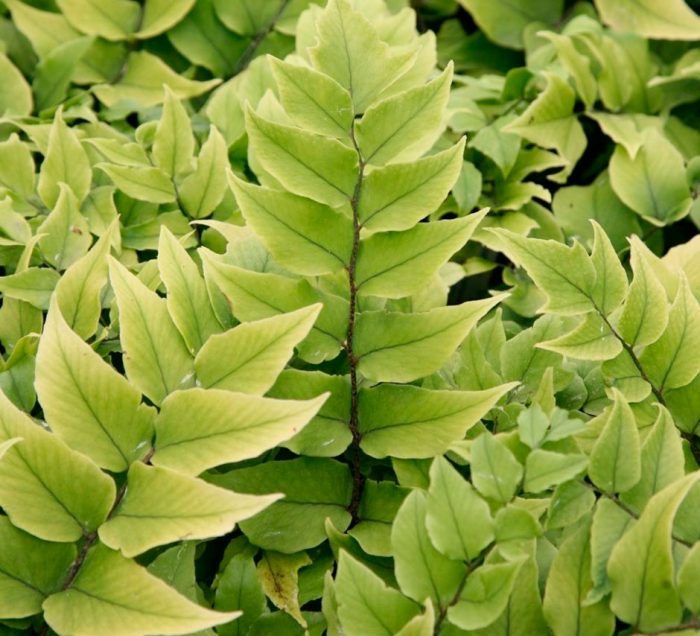
Such a plant is native to the Japanese islands, Korea and China. Most often, the foliage of this fern is lodging, it gradually grows and forms low dense thickets (clumps). In diameter, such thickets can reach up to 100 centimeters, while their height varies from 30 to 60 centimeters. Ovate, oblong, or triangular leaf lobes are pale gray, dark green, or greenish in color. Unlike other species, the leaves are located on the petiole relatively far from each other. The petiole can be colored dark brown or brownish, and its length can reach 10 centimeters. On the surface of the median vein, there is pubescence, while one leaf frond contains from 20 to 30 pieces of leaf lobes.
This species differs from the rest in the greatest resistance to frost, therefore it is often cultivated in open ground conditions. However, so that the bush does not freeze out in winter, it must be well covered. But it should be noted that with the onset of spring, the fern will lose its former attractiveness. And in regions with frosty winters, the bush does not survive until spring.
The most widespread variety among florists is “Сlivicola”. Its narrow greenish-silvery leaf lobes have serrated edges.
Cyrtomium caryotideum
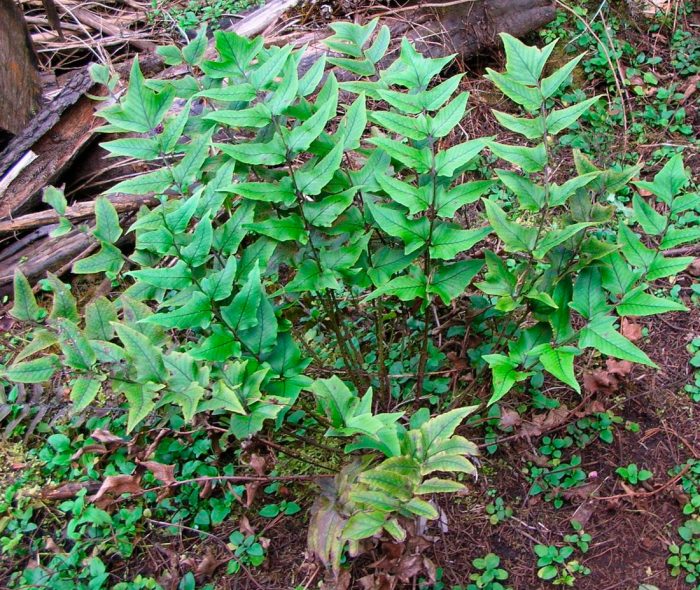
The surface of the rhizome is covered with brownish scales. A dense bush consists of many erect leaf days, and its height can reach up to 0.7 meters. Quite large leaflets are part of the feathery leaf wai, on the uneven edges of which there are short teeth. As a result, the leaf is prickly to the touch.
The structure of the leaf plate includes 3–6 pairs of broad-lanceolate leaf lobules. They are covered with a grayish-green bloom, and there is sharpening at their top. Due to their unusual shape, the leaflets look like a feather. The surface of the petioles is covered with a dense layer of greenish-gray scales. There are also scales on the seamy surface of the front, but their shape is threadlike. Outwardly, the bush is not much like a fern.
Large-leaved Cyrtomium macrophyllum
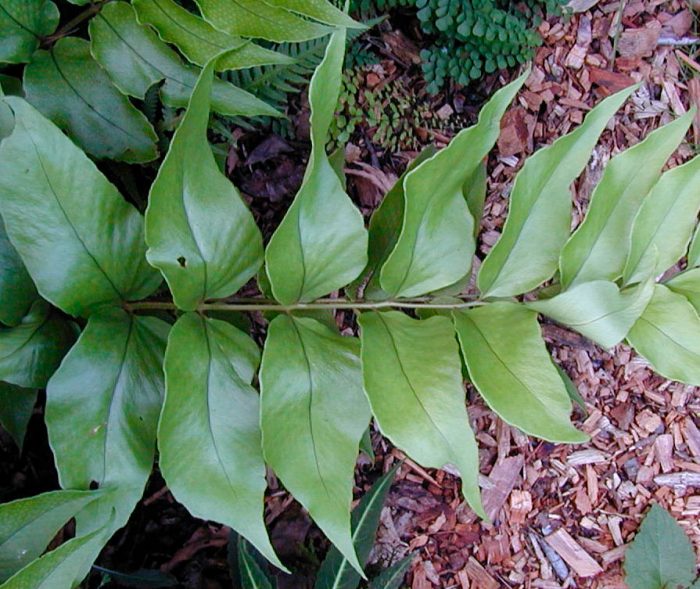
The front has large glossy leafy lobes on a rigid petiole. Leaf plates are similar in shape to a feather. They reach about 0.3 meters in width and up to 0.7 meters in length. Narrow paired leaf lobes are distinguished by an oblong-lanceolate shape, their apex is pointed. One sheet plate contains from 2 to 8 pairs of leaflets. On the seamy surface of the leaf plates, you can see pale gray or dark green rounded sporangia.
Cyrtomium hookerianum
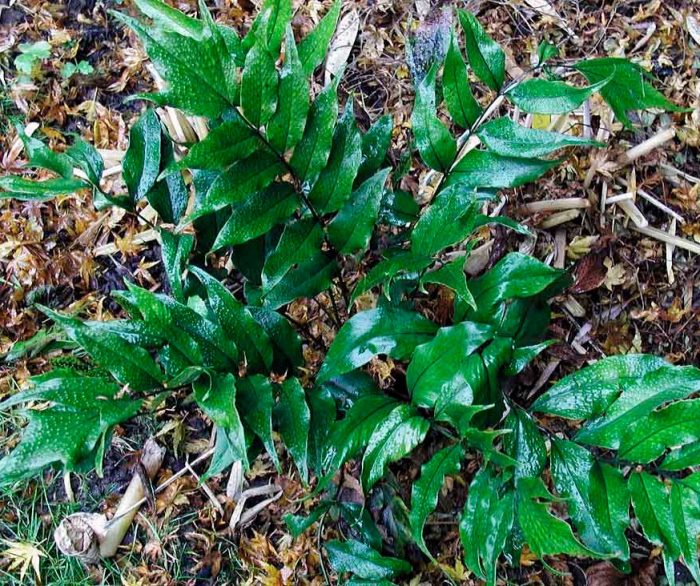
Over time, the overgrown bush forms a spreading curtain. One frond may contain from 10 to 15 pairs of greenish leaflets, which differ in their broad-lanceolate shape. The maximum width of leaf lobes is 5 centimeters, and in length, they can reach 12-15 centimeters. This species is the least common in indoor culture.


